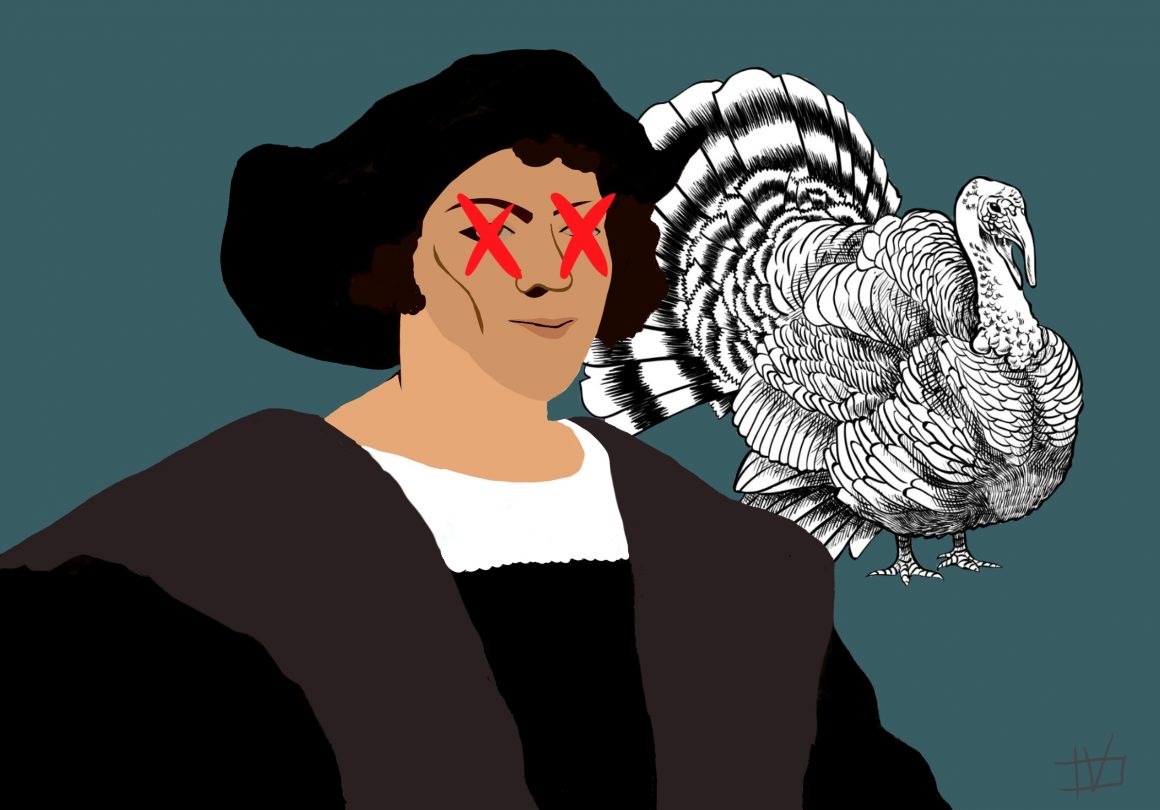
What is Canadian Thanksgiving really about?
By Nimra Amir, October 21 2021—
The general origins of Thanksgiving in the West are often romantically depicted as the sharing of a feast between European settlers and Indigenous peoples to commemorate the first successful harvest season — mainly with pumpkins, potatoes, corn and turkey. This narrative is regarded as a beautiful story about how people, despite their differences, came together as one. However, like most of Western history, this narrative has been directed by white people to erase the atrocities that they have committed against Indigenous peoples.
In Canada, Thanksgiving honours the French explorer Samuel de Champlain, who invited the local Mi’kmaq to a feast in Port-Royal on Nov. 14, 1606. Hosted as part of the broader “Order of Good Cheer” dinner party series, this feast was intended to supply colonists with enough meals to prevent any further scurvy and malnutrition.
It is at the first Thanksgiving that Marc Lescarbot performed the first European play in North America, Le Théâtre de Neptune en la Nouvelle-France. In the play, the Indigenous peoples had not only sworn total allegiance to colonial leaders but even recognized the sovereignty of the Europeans. These events unquestionably exposed the true intentions of the European settlers at this feast as establishing the “Indian” role as inferior.
The fact that the colonists had survived as long as they did is owed to the Mi’kmaq, since it was the Mi’kmaq that had taught them how to appropriately gather food based on the area they were located at — for example, their ice-fishing techniques. Further, by serving as intermediaries, the Mi’kmaq had even enabled the colonists to participate in fur trades with groups in the West.
Despite these somewhat promising initial relations, tensions between European settlers and Indigenous peoples substantially worsened in the following year.
As the Mi’kmaq were among the first peoples in North America to encounter European settlers given their proximity to the Atlantic Ocean, they suffered depopulation and socio-cultural instability rather quickly. This resulted not only from diseases like Smallpox but religious conversions to Christianity, treaty violations and a full-fledged war over the Halifax territory. European settlers had no claim to the territory that Mi’kmaq held, as they were Mi’kmaq moose hunting grounds, a religious pilgrimage site and at the meeting point of vital waterways.
Governor Edward Cornwallis, the founder of Halifax, retaliated against the persistence of the Mi’kmaq land claim by offering a bounty for the scalps of Indigenous peoples — a major reason his controversial statue placed in downtown Halifax was voted 12-4 to be removed in 2018 by the regional council.
Historians estimate that the Mi’kmaq population was reduced by half in the 16th century.
Nevertheless, Thanksgiving was not fully implemented in Canada until the 19th century when politicians and businesspeople involved in advancing Confederation grew increasingly concerned with nation-building. Canada needed an identity and the preferred image by those in power was a white, Protestant nation that would marginalize the claims of Indigenous peoples and other immigrants from Asia and Europe.
The establishment of cultural institutions like Thanksgiving by Parliament was crucial in this regard since it reinforced Canada’s white, Protestant image by emphasizing family and religious devotion, while simultaneously trivializing the unjust dominance of Indigenous peoples like the Mi’kmaq, where the holiday originated.
Yet like all other groups, Indigenous peoples are not a monolith – there are varying opinions on Thanksgiving. Some communities regard the holiday as a National Day of Mourning for Indigenous peoples that have been killed over decades of violence and mistreatment.
Parallel to this view is the belief that Thanksgiving serves as a day of protest against the oppression that Indigenous peoples continue to experience.
However, other Indigenous peoples hold that the practice of giving thanks for the bounty of the land preceded the arrival of Europeans in North America by thousands of years. In this way, Thanksgiving today is just a continuation of their ceremonies.
The Haudenosaunee, for example, express their thanks every day. The Thanksgiving Address, or Gano:nyok, they observe daily acts as a reminder to appreciate the interconnectedness of all areas of life.
Whatever approach through which you choose to observe Thanksgiving, we must do so with a thorough understanding of the historical context it originated from. While the reality is much more brutal than the stories we are comfortable with, it acknowledges the struggles that Indigenous peoples were faced with.
We must give thanks for the food we consume, the Indigenous lands we inhabit and for the Indigenous people who have historically accommodated settlers and immigrants — without their generosity and guidance many of us would not be here today.
This article is part of our Opinions section and does not necessarily reflect the views of the Gauntlet’s editorial board.
